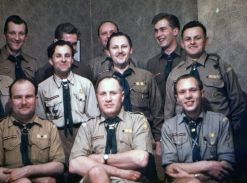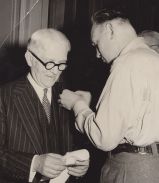Latvians first became acquainted with then principles of Scouting during the First World War whilst at school in Russia. Having returned to Latvia in the 1920s they decided to set up a Scout organisation following contact with Lord Robert Baden-Powell, and collaboration between Latvia's and Britain’s scouts flourished. However, the movement was abolished by invading powers in the Second World War and the Scout leader, General Kārlis Goppers, was executed by the Soviet regime. The movement was not forgotten and was resurrected by young Latvians in German refugee camps.
After immigrating to England they soon formed a number of scout troops in their work camps. As many of these young men were already over the age of 18, they became Rover Scouts, the adult branch of the Scouts Association. Following discussion with British scouting headquarters, the Latvians created their own scout troops within the host British scouting movement. In 1947, there were 9 scout troops with new ones in the process of being formed and two scout districts came into being, one based in Coventry and the other in Manchester. At that time there were eight cubs, nine scouts, seven independent scouts, 70 rovers and 24 leaders in England. In 1950, the Latvian scouting movement was granted a degree of autonomy, all the while swearing loyalty to its host country. This meant that Latvian scouts could use the Latvian flag, wear their own style of uniform and agree on their own working methods. M. Vētra was designated the Latvian association leader (i.e., covering the territory of England), and following his emigration, Indulis Kažociņš was elected as overall leader, followed by J. Tavars, then E. Asmanis, who remained in position until the association was liquidated in 1962.
The scattered homes of individuals and lack of funds meant that two districts could not be maintained, so they were amalgamated into one, and, even though the number of scouts was small activities still took place. There were three levels of programmes, with badges or rings being awarded as a scout completed a level. Care was taken to raise the scouts in Latvian awareness and the badges were based on Latvian ethnographic designs. They were provided by the Latvian Welfare Fund.
General scout meetings happened: in 1952, nine people gathered in Huddersfield; in 1953, eight gathered near Derby; in 1954, four participants took part, again near Derby. In the whole of the English association only four scout troops remained in 1954. Rovers met annually up to 1956, as did general meetings of leaders, but as numbers had decreased (in 1956 only seven leaders from two scout troops attended) so these meetings ceased. Bradford was the only official location for older scouts, but the members were scattered throughout England. Traditionally they met around Christmas, and occasionally gathered at the “Latvian Home”, Almeley, to help with tidying Latvian graves in the village churchyard or other works round the house.
Corby was the only place that had a sizeable number of boys and in 1952 the scout troop originally founded in the Alsager work camp was renewed in Corby, but it was registered under a British scout district. The troop was supported by the Latvian Welfare Fund and had its own parents’ committee.
From 1 to 13 August 1957, a jamboree was organised by British scouts to commemorate 50 years of scouting, to which ten Latvian scouts and one leader were invited, with one place offered to a Latvian representative at the international conference. The Corby scouts were the only ones who could respond to this invitation, but there were only seven of them, so the number was supplemented by three Latvian scouts from Oldenburg, Germany. The attendance costs were covered by the Latvian envoy Kārlis Zariņš and Prof. A. Spekke, the Committee for the Freedom of Latvia, the Latvian Welfare Fund, and General Goppers Foundation. The Corby Branch of the Latvian Welfare Fund donating the Latvian national flag, which flew proudly alongside the flags of other nations. The gates to the camp were decorated with the coats of arms of Latvian towns, and these were made by Corby’s Latvian craftsmen.
The Corby scouts continued to be active for a further two years or so, but gradually the numbers dwindled as the scouts grew older and left the troop. The few Latvian cub scouts left by 1960 operated effectively within English scout troops, with Latvian leaders overseeing those aspects that were purely of a Latvian nature. With changes in leadership even this activity ceased. An attempt was made to create a European Latvian Association across England, Germany, and Scandinavia, but this came to nothing. The older scouts continued their annual meetings until 2007, officially being affiliated to the Canadian Association.





